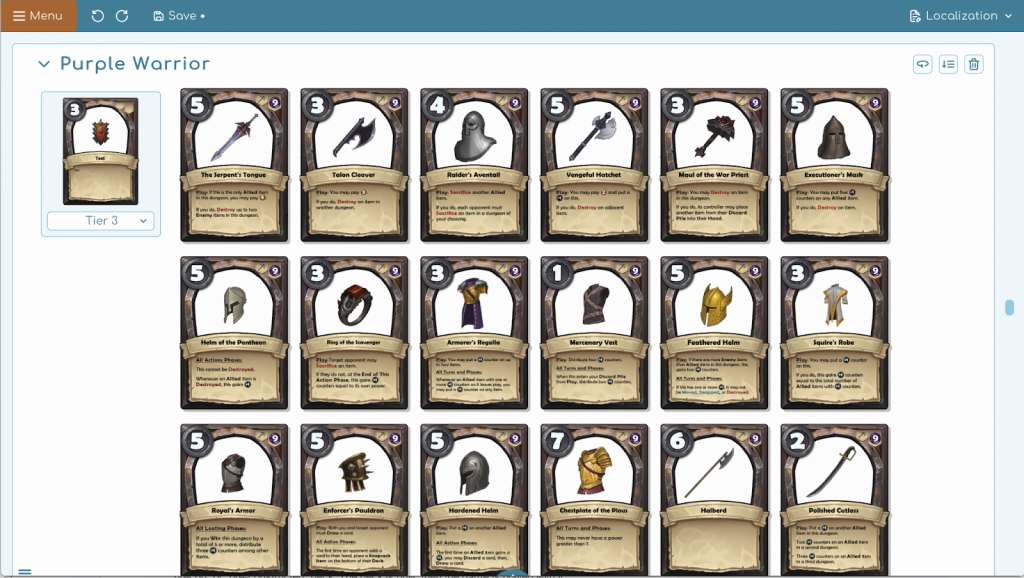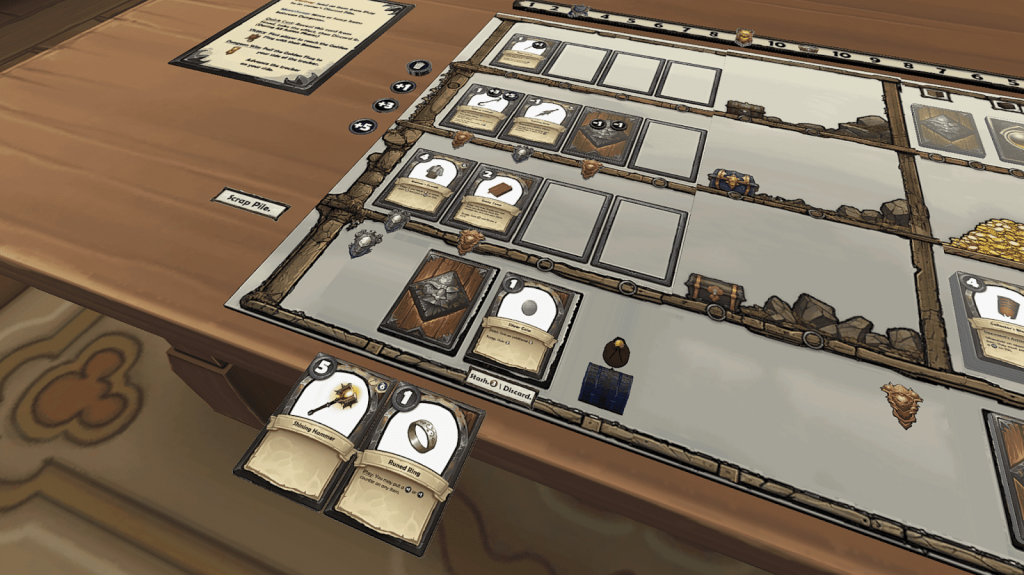Let’s talk about deck building! Welcome back to the Tabletop Creator’s blog, and we are really excited to share this insightful article written by Nathan, the creator of Loot Box. Nathan’s understanding for deck-building will definitely help game designers understand the mechanics and nuances of this engaging genre.
We also invite you to join Nathan’s community on Discord, where you can discover more about his game, Loot Box, share your ideas, and connect with other passionate game designers.
Hey everyone! My name is Nathan. I’m the designer of Loot Box!, a head-to-head deck builder with area control elements in which you manage an inventory of items for your guild. I want to share some insights with you today regarding how to approach deck builder design.
Over the last two decades the “Deck-Building” genre has become a cornerstone in both digital and tabletop gaming. At its core a “Deck-Builder” is a game which uses cards as a fundamental component, but, unlike card games where players draw from a communal stack, deck builders allow players to expand and manipulate decks of their very own.
In this way each player defines a unique play style. And as a result of the many different card combinations available, these games offer a high degree of replayability.
My personal love for deck building began long before I knew the term in the context of game design however, and long before I played a modern “Deck-Builder”.
The first decks I ever built were in seventh grade, my bedroom floor a chaotic spread of Magic: The Gathering cards. Constructing Magic decks was a thrilling pursuit, a quest for obscure combos – like writing code with cardboard.

The DNA of Deck Building in Game Design
The fact is that Trading Card Games (TCGs) like Magic share a lot of DNA with the modern deck builder design. After all, one of the primary player experiences in TCGs is that of constructing the deck, brewing those “broken combos”. This type of deck building is known in the TCG community as making a “precon” or “pre-constructed” deck. The deck is built, then the game is played with it.
When talking about “Deck-Building” as a modern genre however, I am referring specifically to games in which the deck is both constructed and utilised literally within the course of a single play session. For me, this approach evokes those same feelings of excitement, that same desire for the “infinite combo” that creating MTG “precons” did when I was young – but all packed into about 60 mins.
In this post we’ll explore deck-building mechanics and their role within the design space of some of the best known games in the genre, as well as in my own design. I’ve broken these approaches down into a few subcategories. Hopefully the information here can provide a jumping off point for creating a deck builder of your very own.
Market Dynamics in Deck Building Games
In Deck Builders the term “Market” colloquially refers to a set of cards which players add to their deck. So it is generally from the “Market” that the deck is built. This Market may express itself in a few different ways and at different times over the course of play. In some deck builders the “Market” makes up the majority of the game. In others it has a more muted presence.
Market availability in board games
The Market usually answers the question of “Where do players get the cards to build their decks?”, but when players are allowed to access the Market is an important point of design tension. I’ve broken Market accessibility into two key timestamps:
Between Rounds\Turns:
- Examples: Balatro, Slay the Spire.
- Impact: Markets accessed between rounds offer strategic planning opportunities outside of immediate gameplay. Players can deliberate on their choices without the pressure of an ongoing turn. This setup creates a space for thoughtful decision-making and introduces a separate strategic phase where players can plan their next moves.
During Rounds:
- Examples: Loot Box (my own game), Dominion, Tyrants of the Underdark, Heat, Ascension.
- Impact: Markets used during rounds influence real-time decisions and strategies. Players must balance their immediate needs with long-term plans, often making quick, tactical choices. This dynamic creates a sense of urgency and immediacy, forcing players to make impactful decisions on the spot.

Play Spaces in board games
Once the mechanisms which allow players to create their decks are in place, the question of how you want the deck to interact with the rest of the game becomes crucial. The next important variable within the genre is something I’ll coin as the Play Space – “Where is the action taking place?” essentially.
I have identified three different “Play Spaces”: three different ways that, as the deck is built, it is also utilised. I’m calling these play spaces the Core Engine, the Dynamic Arena, and the Persistent Battleground.
Play Space 1: Core Engine (Dominion, Balatro)
A Core Engine Deck Builder refers to a design in which the deck itself is the primary play area. Players focus on building and refining their decks to generate resources, create combos, and min/max performance. These games present consistent, fairly static goals. The deck plays with\against itself in a sense – player interaction may be low or non-existent. The deck only needs to do one thing, that thing rarely changes, and it needs to do that thing really well.
Player Experience: This approach appeals to players who enjoy methodical and strategic gameplay. The consistent goals allow for detailed planning and execution of long-term strategies. Players focus generally on long-term strategy over immediate adaptation or pivots.
Play Space 2: Dynamic Arena (Slay the Spire, Ascension)
The Dynamic Arenainvolves transient goals that change over the course of the game. Players must adapt their strategies to meet evolving challenges and objectives. Not only are these challenges dynamic, but they also exist “outside” of the deck or Core Engine. For instance: “enemy intention” in StS or the highly dynamic market in Ascension provide a reactive landscape in which to play cards.
While the obstacles the deck must overcome are often changing, the way that the deck meets those challenges is still highly similar to the Core Engine approach. The deck looks most often toward internal interactions and combos in order to generate value.
Play Experience: This model keeps players engaged through an unpredictability that can lead to exciting, tense moments. Players will enjoy this style if they like to think on their feet while they build and adapt their card engine.
Play Space 3: Persistent Battleground (Loot Box, Clank!, Tyrants of the Underdark, Heat)
The Persistent Battleground approach requires players to leverage their decks within a permanent play space – a board. The board represents a persistent zone where the impact of players’ actions is felt continuously. This model adds a layer of depth to deck-building games as players must consider both their deck and their position within a “board state”. The result is complex and engaging gameplay in which the strategies are heavily dependent on player interaction. Compared to the Core Engine and Dynamic Arena models, a Persistent Battleground deck builder will feel less like making a deck so that “number go up”, and more like making a TCG styled “pre-con” over the course of the game.
Play Experience: Players who thrive on deep tactical interactions will find this style engaging. Fans of both tactical card games and RTS style video games may find the Persistent Battleground deck builder is their cup of tea. This model requires dynamic pivots, macro strategy considerations, and involves high levels of player interaction.

In TLDR:
Core Engine: Create a powerful, self sustained resource generation engine to achieve a fairly static, predefined goal.
Dynamic Arena: Build a deck or “engine” that must be able to adapt to dynamic challenges in a play space beyond itself.
Persistent Battleground: Develop a deck to strategically interact with and influence a permanent play area, where player actions have lasting impacts on a “board state”.
Thanks for reading! I hope this gives you some food for thought in your own designs. I’ve found Tabletop Creator to be an indispensable tool in the process of iterating a deck builder (There are a lot of cards!). Happy Designing!


